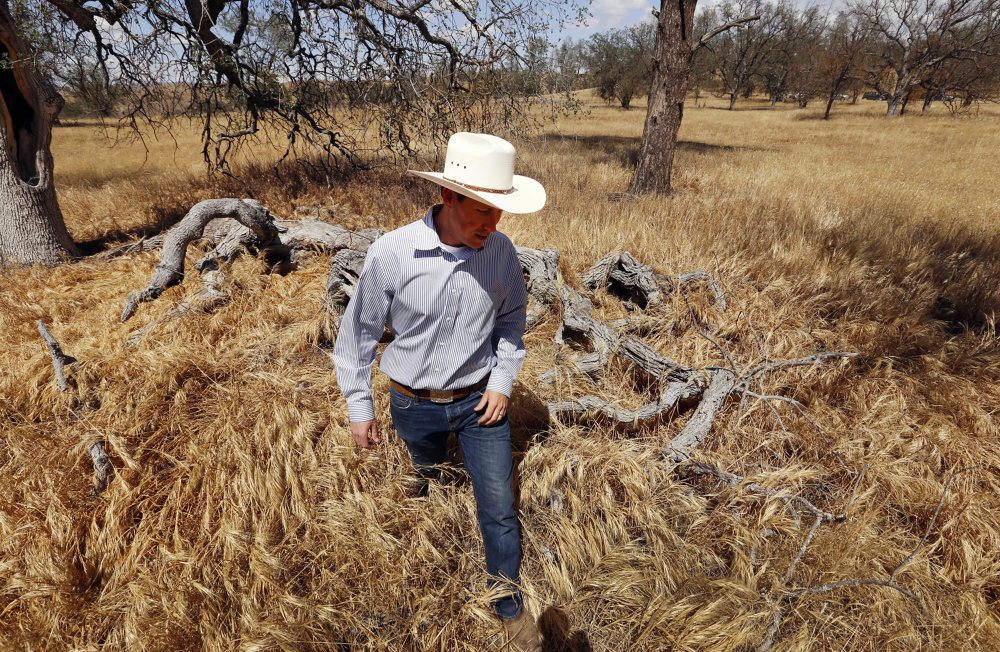The owner of cafes in Belfast and Bangor made headlines recently when he announced he was going to stop using almonds and almond milk in the items on his menu. The reason? The ongoing drought in California.
California is the No. 1 producer of almonds in the world, accounting for 80 percent of the world’s supply, according to an article in Fortune magazine. Both almonds and pistachios came in second place, in terms of billions of gallons of water consumed, in 2010.
But the situation is much more complicated than you might think.
The top water-consuming crop in California, measured by the amount of water consumed for irrigation, is actually alfalfa. And alfalfa is primarily used, at least in the United States, for feeding cattle. Beef and dairy products from California, therefore, have a much larger “water footprint” than do almonds and almond products.
What does this all have to do with Maine? Several things, actually.
• Not all dairy or beef products are created equal. So, before you put down your Greek yogurt (or flat iron steak) in a panic, remember that there’s a world of difference between milk from a cow fed on water-subsidized crops, and milk from a cow fed responsibly in an area where water is abundant.
The out-of-pocket cost to you may be a little higher when buying a burger made of beef from local, grass-fed cattle, but the true economic costs (which include the full cost of the resources used to create a pound of beef) are not. If the price of the food we eat is to adequately reflect the full cost of the product, we must consider things such as the water, energy and resources used to produce that good.
• If the drought goes on much longer or becomes much more severe, the higher prices for agricultural products from California likely will ripple through the U.S. economy. California produces more than 90 percent of the country’s artichokes, walnuts, kiwis, plums, garlic and celery, just to name a few. U.S. consumers already are starting to feel the pinch, but the ultimate effect is uncertain.
Several factors affect the price of commodities, including global supply and demand; whether price effects trickle up the supply chains to make it to the consumer; the ease with which farmers can divert scarce water from one commodity to another (what economists call input substitution); and the price elasticity of demand (whether consumers react to a price increase by buying less, or by simply paying the higher price).
Many farmers are responding to the drought by diverting water from less profitable crops, such as hay, to more profitable ones, such as nuts.
More disturbing, however, is that some farmers who are receiving less than their allocated share of surface water in California’s anachronistic water rights system are increasing the rate at which they pump groundwater to make up the difference. This can lead to land subsidence and saltwater infiltration into coastal aquifers, and can worsen future water shortages.
• Maine needs to rethink how water rights are allocated and used in this state. Although changing our consumption habits to reduce our “water footprint” might be an admirable thing to do, it doesn’t address the main source of the problem: California’s system for allocating water rights.
That system has its roots in the Gold Rush era, where land was abundant and population scarce.
Unlike most Northeastern states, Western states primarily have a system of water rights known as “prior appropriation,” where the right to use surface water went to whoever first staked a claim to a certain gold mine and used the water for sluicing.
Senior claimants — those who had claims before 1914, when the State Water Resources Control Board was founded — did not see their water rights curtailed until June 12, in what is likely to be a heavily contested action. In addition, for the first time in its history, California has implemented a new groundwater management system. It may have come too late.
New England in general and Maine in particular are blessed with abundant ground and surface water supplies, and our groundwater extraction rules reflect that abundance. But as California is finally beginning to discover, systems of laws and regulations that were created a century ago do not necessarily adapt well to the pressures of scarcity.
We might do well to take a lesson from California’s predicament, and take this opportunity to revisit Maine’s large-scale water extraction laws.
No drastic actions may be necessary at this time. But we need to make sure that the incentives in place can be modified to fit an uncertain future.
Rachel Bouvier of Portland is founder and principal of rbouvier consulting (www.rbouvierconsulting.com).
Send questions/comments to the editors.




Success. Please wait for the page to reload. If the page does not reload within 5 seconds, please refresh the page.
Enter your email and password to access comments.
Hi, to comment on stories you must . This profile is in addition to your subscription and website login.
Already have a commenting profile? .
Invalid username/password.
Please check your email to confirm and complete your registration.
Only subscribers are eligible to post comments. Please subscribe or login first for digital access. Here’s why.
Use the form below to reset your password. When you've submitted your account email, we will send an email with a reset code.